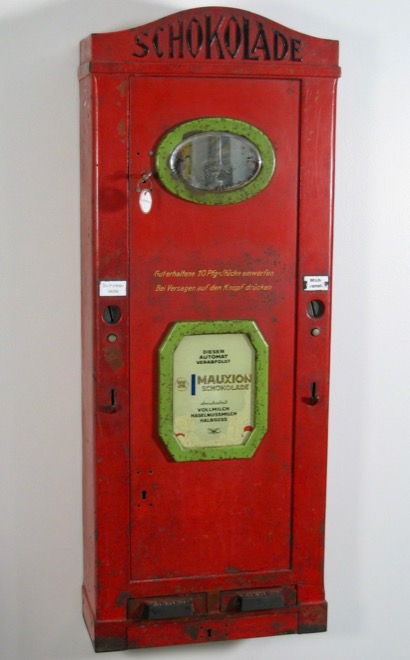___________________________________________________________________________________________
Schokolade

___________________________________________________________________________________________

Germany or Austria, c. probably 1890's or very early 1900s, 34". This is not listed in Silent Salesmen Too and I've seen only one other example. I owned that other example but traded for this one because I liked this one better and he liked the other one better. Win-win, right? I bought the first one at the Chicagoland show in 2004 because I was struck by the overall look and presence of the machine, and traded it for this one about 4 years later. It's made of cast iron and very thick steel and weighs about 80 pounds. This ain't a machine for sissies!
I've titled the machine "Schokolade" because that's what it says along the top, but that merely means "chocolate" in German. I don't know who made this or when it was made, although I'd be surprised if it were made after 1910. You can see the writing on the front more clearly here on the first one I owned, but I don't read German so the text doesn't mean much to me. If you can translate it for me, please do so and I'll update this page to include its meaning. The tags above the coin entries are made of porcelain.
I can't tell you how this works because I haven't figured it out yet. It has 2 columns, with a coin entry for each. There's no manual operation on the outside---such as a knob or slide---so it's likely that inserting a coin trips something inside, which causes the mechanism to release the product to one of 2 cast iron, spring-loaded drawers at the bottom of the machine. Each mechanism is sandwiched between a product column and the outside wall of the vendor, and is not readily accessible without removing the mechanism. I've not done that, but I can tell that the mechanism is not clockwork-driven. This machine has a coin return below each coin insert, which strikes me as a pretty advanced feature for a machine of this era.
This example is 100% original. It's probably intended to be wall-mounted, but that's not obvious from the back. The only hole is a single 1 inch hole in the top middle of the back. For a long time I was afraid to let a single point of attachment support such a heavy machine, so the machine sat on the floor along a baseboard where it looked fine, but it wasn't right. I finally figured out a way to mount it, which is this:
I built a short "shelf" to support it underneath. The shelf is a 1" by 2" piece of wood, available at any hardware store, cut to nearly the width of the machine and mounted so the shelf is 2" tall and protrudes only 1" from the wall. I mounted the shelf to the wall with a long, sturdy screw through the center of the shelf into a stud, and then with 2 smaller screws through the outer part of the shelf into dry-wall anchors to keep the shelf level. Once I did that I hoisted the machine up onto the shelf, pushed the top of the machine back against the wall, and used a good dry-wall anchor to keep the top of the machine against the wall. The system worked perfectly, and the shelf---which I painted to match the wall---is completely unobtrusive.
___________________________________________________________________________________________
___________________________________________________________________________________________
©Small Vintage Vending 2019